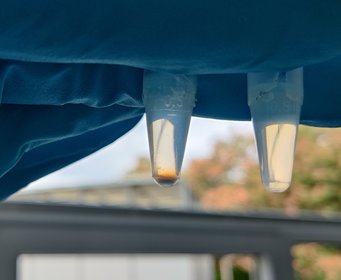Fluorescent diamonds to detect viruses
Carl Zeiss Foundation supports "Utrasens-Vir" research project in Ulm (Germany)
How can viruses be detected quickly and precisely? How can different viral pathogens be distinguished from each other and identified in a single sample? This is where the research project "Ultrasens-Vir" comes in, which is now being funded by the Carl Zeiss Foundation with around 4.5 million euros. The interdisciplinary team of scientists from virology, chemistry and quantum physics is using quantum-based technology. The core of the project are fluorescent nanodiamonds that act as specific sensors to detect viral material.

Diseases caused by respiratory viruses have been a huge challenge for healthcare systems around the world, and not just since COVID-19. In order to prevent the viruses from spreading and to effectively treat viral diseases, early diagnosis of the pathogens is needed. However, appropriate diagnostic procedures - especially apart from the now widely used SARS-CoV-2 detection methods - are time-consuming, expensive and labor-intensive.
The Carl Zeiss Foundation is now supporting a research team consisting of scientists from the University of Ulm and the Max Planck Institute for Polymer Research in developing a highly sensitive sensor technology. This method is intended not only to detect viruses quickly and with the greatest accuracy, but also to precisely detect different viral pathogens in a single sample. "We rely on fluorescent nanodiamonds, and thus on quantum optical effects," explains Rüdiger Gross, working group leader at the Institute of Molecular Virology. "Our technology uses the unique quantum properties of nitrogen-vacancy centers in nanodiamonds to detect individual viral components of the viral genetic material."
The goal of the project, called "Ultrasens-Vir," is to develop a completely novel diagnostic method that can be used to detect and analyze viral material - at a reasonable cost and with reduced time.
"We at the Max Planck Institute for Polymer Research will be involved in researching an innovative surface functionalization of nanodiamonds," says group leader Yingke Wu from Tanja Weil's department. This functionalization will enable the application of nanodiamond sensors in biological media in the first place. "It is important in the project to develop a new and very thin surface coating that enables efficient docking of viral RNA," Wu added.
Participants in the "Fluorescent Nanodiamonds for Ultrasensitive Viral Diagnostics" (Ultrasens-Vir) project include Professor Jan Münch, co-director of the Institute of Molecular Virology at Ulm University Hospital, Professor Fedor Jelezko, head of the Institute of Quantum Optics at Ulm University, and Professor Tanja Weil, director of the Max Planck Institute for Polymer Research in Mainz.
About the Carl Zeiss Foundation
The Carl Zeiss Foundation has set itself the goal of creating scope for scientific breakthroughs. As a partner of excellent science, it supports both basic research and application-oriented research and teaching in the MINT disciplines (mathematics, computer science, natural sciences and technology). Founded in 1889 by the physicist and mathematician Ernst Abbe, the Carl Zeiss Foundation is one of the oldest and largest private science-funding foundations in Germany. It is the sole owner of Carl Zeiss AG and SCHOTT AG. Its projects are financed from the dividend distributions of the two foundation companies.












